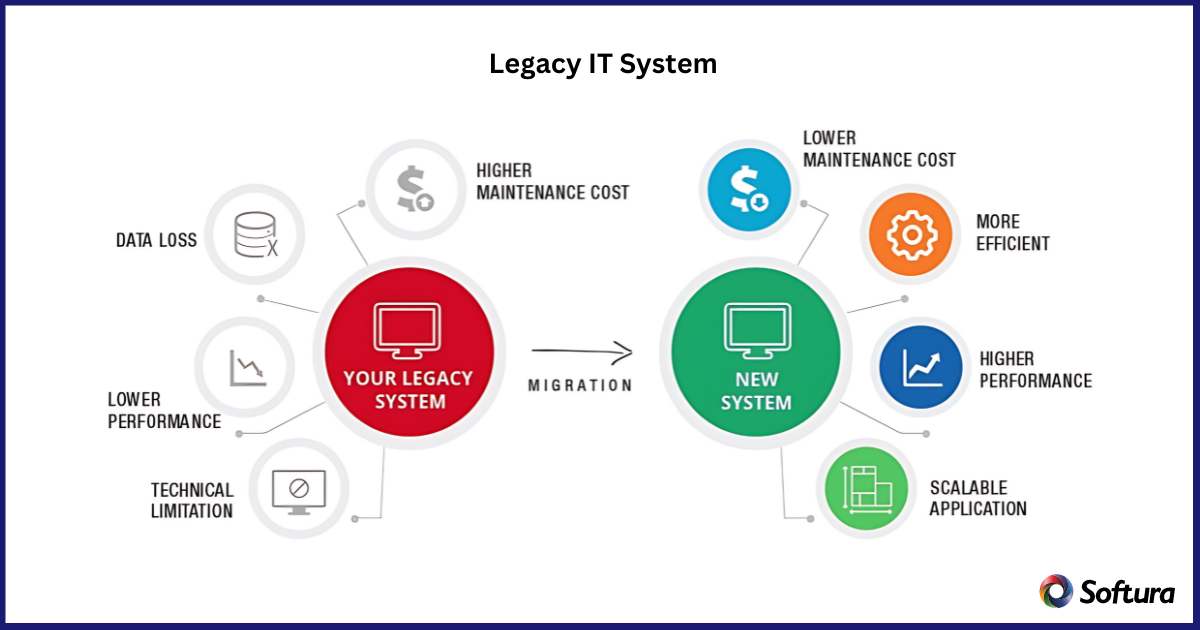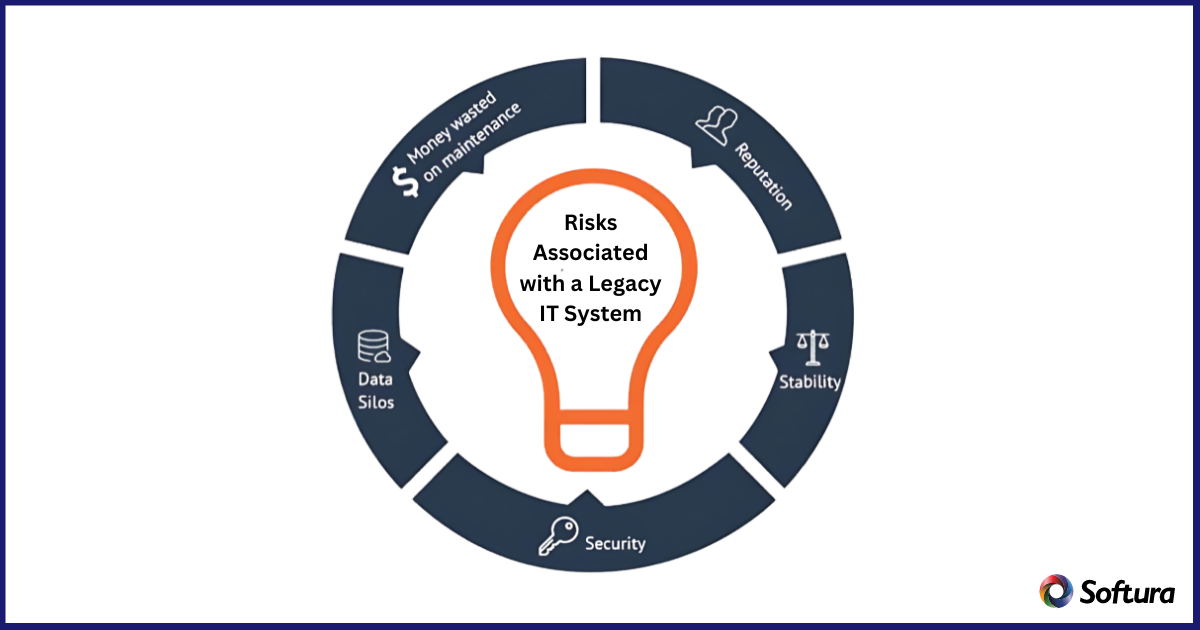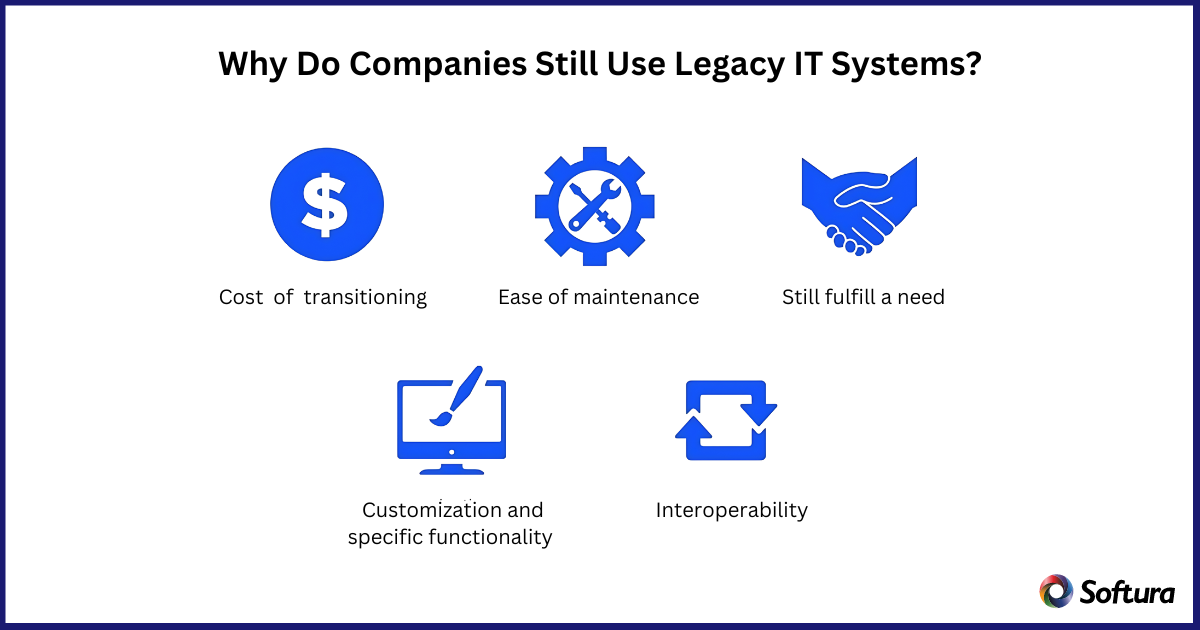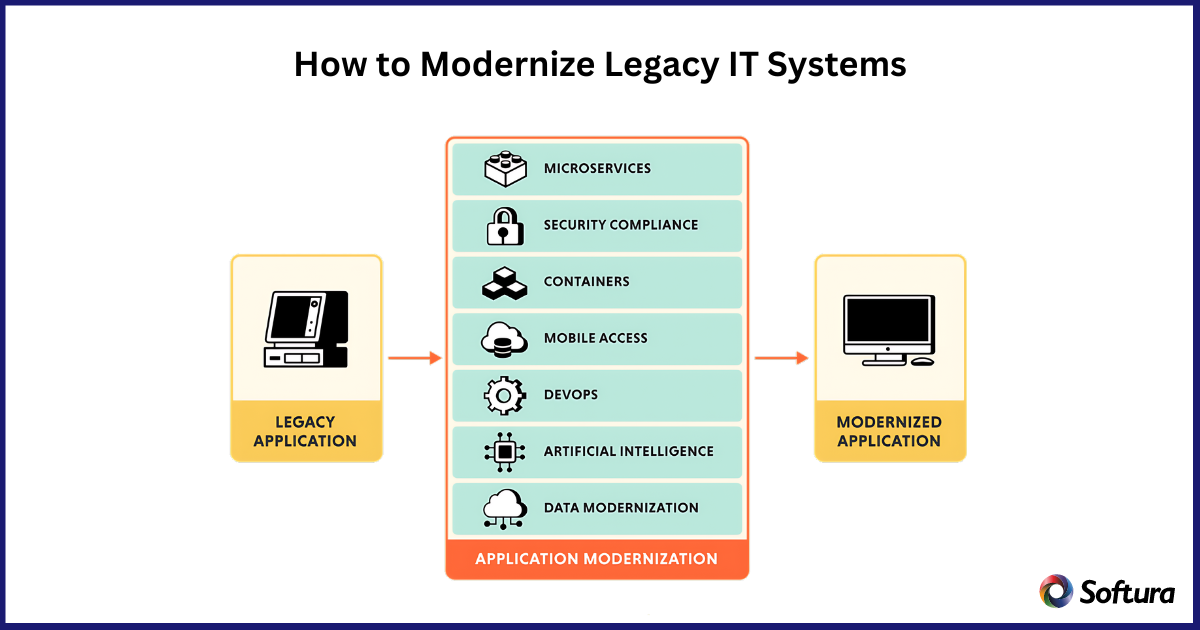"Our integration with the Google Nest smart thermostats through Aidoo Pro represents an unprecedented leap forward for our industry."
- Antonio Mediato, founder and CEO of Airzone.
A legacy IT system refers to older computing software and devices that are still in use even when there are newer and better technologies available. A decade ago, these systems served as the backbone of several businesses, reliably delivering vital services. Their incompatibility with legacy app modernization systems, difficulty in maintenance, and technological obsolescence are their defining characteristics. However, to some extent they are essential to the functioning of the company because of their extensive integration with older infrastructure and business processes

Organizations face many risks when it comes to maintaining old systems:
Security vulnerabilities: Older systems are vulnerable to security breaches because they do not adhere to modern security requirements.
Increased maintenance costs: Maintaining legacy IT systems requires specific skills as there are only a few replacement parts or resources available, the cost might be very high.
Inefficiency and reduced productivity: Operational inefficiencies and decreased productivity are caused by legacy systems' lack of the capability and speed of the latest alternative solutions.
Incompatibility issues: It might be difficult to integrate new technology with legacy systems, which could impedein software application development and innovation.
Compliance Risks: Legacy systems could not adhere to current legal and regulatory requirements, putting businesses at risk of penalties and other consequences. Using outdated technology makes it harder to keep compliant with new standards, particularly in industries like banking and healthcare

Data Loss and Corruption: The likelihood of data loss or corruption is higher with older systems as they are often less dependable when managing data. Significant operational interruptions may arise from system failures, insufficient backup systems, or problems with data storage format compatibility.
Limited Integration Capabilities: It might be challenging to link legacy systems with contemporary apps or services as they sometimes provide few or no APIs. This restriction may make it difficult for businesses to use new technology to improve or broaden their services.
Talent Scarcity: It's becoming increasingly difficult to locate qualified experts to manage legacy IT systems. The shortage of professionals knowledgeable in older programming languages and technologies may increase labour costs and cause important maintenance tasks to be postponed.
Decreased Competitiveness: Businesses that mostly depend on outdated systems may find it challenging to innovate or swiftly adjust to changes in the market. This might result in losing competitive advantage when rivals with more advanced technology can provide superior customer experiences, operational efficiency, and services.
Dependency on Unsupported Software: Many legacy IT systems use software that its creators no longer maintain, which prevents businesses from using patches, updates, or technical assistance. As vulnerabilities remain unresolved, this reliance raises the danger of operational failures and security breaches.
"Our integration with the Google Nest smart thermostats through Aidoo Pro represents an unprecedented leap forward for our industry."
- Antonio Mediato, founder and CEO of Airzone.
Many businesses, however, depend on such outdated legacy IT systems despite these hazards for a few reasons:
Critical business operations: Legacy IT systems often provide support for crucial business processes that are difficult to duplicate or replace.
Data integrity and reliability: It is risky to switch to new systems without a chance of data loss or corruption because of years of gathered data and established dependability.
Cost of replacement: Considering the possibility of operational interruptions, the expense necessary to replace a legacy system may be unaffordable.
Complexity of migration: Making the switch to new, more advanced systems comes with several difficulties, such as retraining personnel and guaranteeing data transfer and operational continuity.

"By analyzing the data from our connected lights, devices and systems, our goal is to create additional value for our customers through data-enabled services that unlock new capabilities and experiences."
- Harsh Chitale, leader of Philips Lighting’s Professional Business.
For their fundamental banking functions, including transaction processing, account management, and client data handling, many banks still depend on mainframe computers and antiquated database systems.
The programming language used in these systems, COBOL (Common Business-Oriented Language), is one such example. COBOL was created in the 1950s, but because of its dependability and effectiveness in handling high transaction volumes, it is still extensively used in the financial industry.
It has been revealed that significant institutions such as JP Morgan Chase and Bank of America rely on COBOL-based systems for their fundamental banking operations. This highlights the difficulty and need to update these antiquated systems without interfering with continuing financial operations.
Patient records, billing, and appointment scheduling are often managed in the healthcare sector using legacy IT systems. These systems were created many years ago, and they are essential to the daily operations of clinics and hospitals.
For instance, the US Department of Veterans Affairs uses an electronic health record system called the Veterans Health Information Systems and Technology Architecture (VistA).
VistA is an example of the healthcare industry's dependence on outdated technology to handle sensitive and important patient data; it is a legacy system that has been in operation since the 1970s.
In order to improve patient care and operational efficiency, updating these systems is crucial due to the sensitivity and complexity of the data involved.
These real-life business cases show how widespread legacy systems are in important industries and stress the significance of modernization strategies that are strategic in nature, protecting vital services while opening doors to innovation and increased productivity.
"By analyzing the data from our connected lights, devices and systems, our goal is to create additional value for our customers through data-enabled services that unlock new capabilities and experiences."
- Harsh Chitale, leader of Philips Lighting’s Professional Business.
Onboard Dedicated Offshore Developers
Develop Mobile application and integrate it into your business processes with Softura's dedicated offshore mobile app developers!
In order to manage legacy IT systems effectively, a balanced strategy that reduces risks and maximizes operational efficiency is required:
"By analyzing the data from our connected lights, devices and systems, our goal is to create additional value for our customers through data-enabled services that unlock new capabilities and experiences."
- Harsh Chitale, leader of Philips Lighting’s Professional Business.
Modernizing outdated IT systems is a wise financial decision that may spur innovation and business expansion. Here's how businesses should go about modernization

Legacy IT systems present a complex challenge for organizations, balancing the need for operational continuity against the risks of security vulnerabilities, increased maintenance costs, inefficiency, and more.
At Softura, we specialize in app modernization, offering tailored application modernization services that align with your business objectives.
If your organization has plans to modernize its legacy IT systems, reach out to us.
Our expertise can help you migrate smoothly to more secure, efficient, and future-ready technologies, ensuring your business remains at the forefront of technology.
"Our integration with the Google Nest smart thermostats through Aidoo Pro represents an unprecedented leap forward for our industry."
- Antonio Mediato, founder and CEO of Airzone.
Are you ready for your next project?
Unlock your company's full potential with our comprehensive Software development services. Contact our experts today to discuss how we can drive your success together.